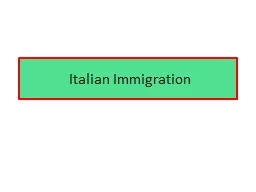

1880 Before there was not a lot of Italian immigration 1881 Census showed only 328 Italians 1914 had risen to 4500 18801914 saw the rise of Italian immigration due to two main factors Better life ID: 360646
Download Presentation The PPT/PDF document "Italian Immigration" is the property of its rightful owner. Permission is granted to download and print the materials on this web site for personal, non-commercial use only, and to display it on your personal computer provided you do not modify the materials and that you retain all copyright notices contained in the materials. By downloading content from our website, you accept the terms of this agreement.
Slide1
Italian ImmigrationSlide2
1880
Before there was not a lot of Italian immigration.
1881 Census showed only 328 Italians
1914, had risen to 4500.
1880-1914 saw the rise of Italian immigration due to two main factors.
Better life
Business opportunities and relatives.Slide3
Poverty
Italians that suffered in agricultural (farming
etc
) areas.
Famine, droughts and poverty were all common in small areas in Italy.
Industrialisation was slow and little hope of getting out of the economic hardships.
Many wanted to follow the American dream in USA.
Scotland a realistic opportunity. (No immigration restrictions.)Slide4
Britain
Some tried to use Britain as a stop gap to USA.
Some unexpectedly stayed.Slide5
Encouragement
By Italians
Lepolld
Guliani
and Luigi
Zacchaine
.
They sponsored young men by paying passage to Scotland and setting up places to stay and live.
Guliani
had several shops around Glasgow and would employ young men.
Possible chance of partnership.Slide6
Encouragement
Zacchaine
did the same and he had shops in
Lossiemouth
.
New immigrants supplied premises and stock in return for half the profits until the cost was covered.
Owning your own business was the ultimate aim.
Possible to return to Italy with their own fortune.Slide7
Life for
Italians in Scotland
Three cities
Glasgow, Edinburgh or Aberdeen.
First skilled workers worked in the 19
th
century and as craftsmen, musicians and street pedlars.
Very quickly became businessmen.
Creation of Ice cream parlours and fish and chip shops.
Not always an easy life. Slide8
Life in Scotland for Italians
Carlo
Gatti
ice cream in Britain.
1850s was a familiar face who peddled around London in a painted cart.
Carts became common.. as did shops..
In Glasgow:
1903: 84 Italian shops
1904: 184
1905: 336Slide9
Working Day
Worked long hours
12 hours a day, 6 days a week.
Living conditions not great.
Most immigrants lived in small flats with young families.
In Glasgow, some moved to the slum area of the
Gorbals
.
Made Italians more determined to improve their lives.Slide10
Explain fully what life was like for Italians that moved to Scotland
(
8
)
Slide11
Relations between Italians and Scots
Not much hostility at all.
Not highly concentrated in small areas.
Italians distributed amongst towns across the country so their shops could grow.
They did not want Scots to feel intimidated or drastically impacted by Italians. Slide12
Tomino
Devino
(
haha
) said:
“The Italians offered a popular service. They were few in numbers and virtually all worked in businesses owned by Italians. They therefore posed little threat either to natives or to wage levels.”Slide13
Hostility
Was occasions when it
happened
.
Cart men were often jibbed at and intimidated by the British youths.
Laughed at because of their poor English and unusual pronunciation.
Stones were thrown into their freezers of their carts and abuse shouted. Slide14
Religion
Roman Catholics
Strict religious beliefs often clashed with Scottish religious groups.
Occasionally Italians would open their shops on a Sunday as their businesses flourished and many Scots disliked this.
Since they were busy, this did not have an impact and the shops remained open. Slide15
Attack on Italians
Organised turn in 1906.
Ice cream parlours, ‘morally contaminated’.
Arguments of late hours, Sunday trading, cigarettes, inappropriate language and behaviour all began to label the ice cream parlours, causing them to loose business. Slide16
Attack
Italians allied with the Temperance Movement. (A movement who urged the limited use of alcohol).
Ice cream and fish shops were persuaded to have a positive alternative to alcoholism.
Newspapers took up the argument and articles were published. Slide17
AT HOME
Italians, when at home, STILL spoke Italian,
ate
Italian food, and only married Italians. Slide18
Tension
No hostility
When Nazi rule of Germany in 1933 happened, fascism was frowned upon.
Italy was fascist under Benito Mussolini, and some Scots tended to believe that some Italians were supporters of him or Hitler.
This caused some tension.
However, most Italians were not supporters and the tension was minimal. Slide19
Tom Devine
“For many Italians, the hope, and for some reality, was eventually to return to Italy, and therefore any attempt at assimilation (to join in) into Scottish society, seemed pointless.”
How far question.